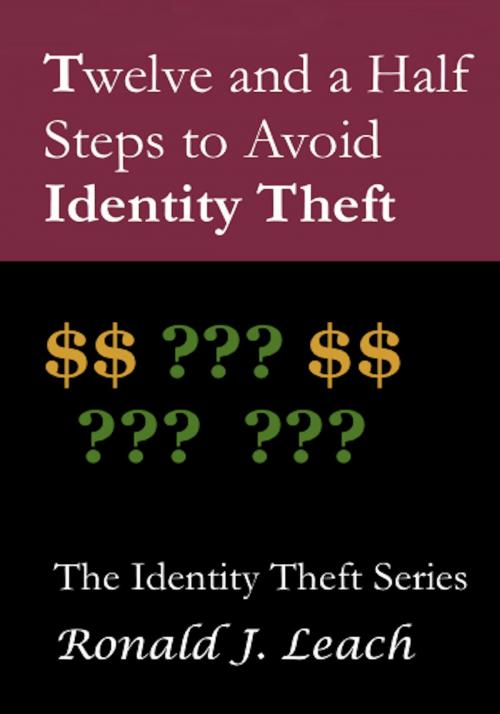Twelve and a Half Steps to Avoid Identity Theft
Business & Finance, Personal Finance, Money Management, Nonfiction, Computers, Internet, Electronic Commerce| Author: | Ronald J. Leach | ISBN: | 9780985368555 |
| Publisher: | AfterMath | Publication: | October 29, 2012 |
| Imprint: | Language: | English |
| Author: | Ronald J. Leach |
| ISBN: | 9780985368555 |
| Publisher: | AfterMath |
| Publication: | October 29, 2012 |
| Imprint: | |
| Language: | English |
Ronald J. Leach's lectures on identity theft have been attended by more than 1,200 people. Many more have heard him on closed-circuit television. This experience, and his long experience as a professor of computer science make him uniquely qualified to write this book.
Do you know how to protect your vital identity information when you use computers for your banking, credit card transactions, and everyday purchases? What about when you are using email, web surfing, texting, or social networking? You’ll learn about these in Twelve and a Half Steps to Avoid Identity Theft.
What do all these companies, organizations, and people have in common?
- Heartland
- RBS Worldpay
- Citizens Financial Group Inc
- Hannaford Brothers Co
- TJX Companies Inc
- Marshalls
- TJ Maxx
- CardSystems Solutions
- The U.S. Internal Revenue Service
- Ben Bernanke, Chairman of the Federal Reserve
- Wyndam Worldwide Corporation (Wyndam hotels)
- Zappos
- Sony’s online accounts for Play Station users
- Verisign
The sad answer is that all of them have suffered well-publicized recent successful attacks from identity thieves. Many of these attacks involved thieves obtaining access to confidential financial information from thousands, and in some cases, millions, of customers.
How can you protect yourselves from this crime? In this book we describe 12 1/2 suggestions that can strongly reduce, or even eliminate, the likelihood of you being an identity theft victim. Why 12 1/2 steps? Because twelve of the steps are ones that you can begin to take right away, and the other will require you to do some additional work reading up on this vital topic.
Here are the twelve and a half simple steps to help avoid identity theft:
- Strip to a bare minimum
- Don’t Pameiob
- Be strong
- Watch for zombies
- Watch for vampires
- Free is too costly
- Don’t give too much credit
- Surf safely
- Gullible’s travels
- Don’t give it up if you don’t have to
- Just the FAX, please
- Be shrewd and shred
12 ½. Get more information
This short, easy-to-understand book, intended for the general, non-specialist reader, will tell you what to do and what to avoid when going to a bank, pharmacy, or doctor; shopping in person; traveling; or using any kind of electronic commerce. You’ll learn about the most common security weaknesses of modern banking and e-commerce software and when to avoid using certain software systems, the tell-tale signs of potentially insecure transmission of your data, and how to avoid the dangerous practice of “Pameiob.” You'll learn how you have to protect yourself from the kinds of identity theft that can occur even if YOU never do any online shopping.
This book is a brief, easy-to-understand guide that is dedicated to keeping your assets and identity safe while navigating this dangerous world. The book is based on the author's experiences as a long-term identity theft consultant and lecturer and computer scientist.
Want more detailed information on identity theft? Then “Identity Theft in the Cyber Age” is the book for you.
Ronald J. Leach's lectures on identity theft have been attended by more than 1,200 people. Many more have heard him on closed-circuit television. This experience, and his long experience as a professor of computer science make him uniquely qualified to write this book.
Do you know how to protect your vital identity information when you use computers for your banking, credit card transactions, and everyday purchases? What about when you are using email, web surfing, texting, or social networking? You’ll learn about these in Twelve and a Half Steps to Avoid Identity Theft.
What do all these companies, organizations, and people have in common?
- Heartland
- RBS Worldpay
- Citizens Financial Group Inc
- Hannaford Brothers Co
- TJX Companies Inc
- Marshalls
- TJ Maxx
- CardSystems Solutions
- The U.S. Internal Revenue Service
- Ben Bernanke, Chairman of the Federal Reserve
- Wyndam Worldwide Corporation (Wyndam hotels)
- Zappos
- Sony’s online accounts for Play Station users
- Verisign
The sad answer is that all of them have suffered well-publicized recent successful attacks from identity thieves. Many of these attacks involved thieves obtaining access to confidential financial information from thousands, and in some cases, millions, of customers.
How can you protect yourselves from this crime? In this book we describe 12 1/2 suggestions that can strongly reduce, or even eliminate, the likelihood of you being an identity theft victim. Why 12 1/2 steps? Because twelve of the steps are ones that you can begin to take right away, and the other will require you to do some additional work reading up on this vital topic.
Here are the twelve and a half simple steps to help avoid identity theft:
- Strip to a bare minimum
- Don’t Pameiob
- Be strong
- Watch for zombies
- Watch for vampires
- Free is too costly
- Don’t give too much credit
- Surf safely
- Gullible’s travels
- Don’t give it up if you don’t have to
- Just the FAX, please
- Be shrewd and shred
12 ½. Get more information
This short, easy-to-understand book, intended for the general, non-specialist reader, will tell you what to do and what to avoid when going to a bank, pharmacy, or doctor; shopping in person; traveling; or using any kind of electronic commerce. You’ll learn about the most common security weaknesses of modern banking and e-commerce software and when to avoid using certain software systems, the tell-tale signs of potentially insecure transmission of your data, and how to avoid the dangerous practice of “Pameiob.” You'll learn how you have to protect yourself from the kinds of identity theft that can occur even if YOU never do any online shopping.
This book is a brief, easy-to-understand guide that is dedicated to keeping your assets and identity safe while navigating this dangerous world. The book is based on the author's experiences as a long-term identity theft consultant and lecturer and computer scientist.
Want more detailed information on identity theft? Then “Identity Theft in the Cyber Age” is the book for you.















